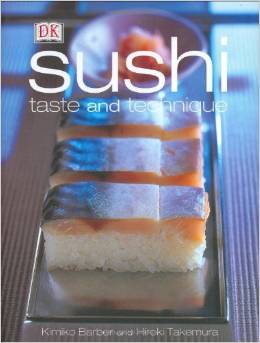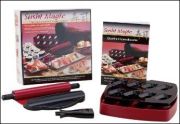Sushi
Taste and Technique
Book Review
My first impression when I opened the book, "Sushi taste and technique" and flipped through it was that it was a beautiful book.
Pretty, well-lit, gorgeous pictures graced every page and they all looked appropriate for the subject matter.
The book is written by Kimiko Barber and Hiroki Takemura.
But now that the initial impression has worn off, it is time to get down to the business of checking out this book in detail.
While a first impression of pretty pictures is one thing; a well-written book wrapped around all of those pretty pictures is yet another.
So let's see how well the wrapping on this book has been done, shall we?
Sushi Taste and Technique - Book Details:
Pages: 255.
Pictures: Yes. Professional quality.
Major Book Sections:
- What is Sushi?
- A history of sushi
- The sushi chef's training
- Health benefits
- Utensils
- Ingredients
- Basic Recipes
- Round and flat fish
- Shellfish and roe
- Scattered sushi
- Stuffed sushi
- Rolled Sushi
- Hand-formed sushi
- At a sushi bar
- Etiquette
- What to drink
- Sushi at Home
- Troubleshooting
- Glossary
- Notable restaurant directory
- Specialty retailers
- Index
- Acknowledgements
Sushi taste and technique begins with a definition of "What is Sushi". A short history of sushi and its arrival in Japan is covered along with how it has changed over the years.
The Sushi Chef's Training
Next the book talks about what it takes to become a real Japanese sushi chef, the star of which is one of the author's of this book Hiroki Takamura. It delves into his start as an apprentice in Matsuyama, Japan all the way to London and finally to New York where he worked in Nobu's New York restaurant. He truly is one of the old school champions of his art.
Health Benefits of Sushi
A brief chapter on the health benefits of sushi is covered. Nothing real deep. Just informative.
The Basics
The basics of things like utensils, tools, and ingredients are covered well. A description of each with pictures along with preparation instructions for some ingredients are given.
Basic recipes are covered including ones for dashi (Japanese stock), tamago (egg omelette), and sushi rice along with many others.
Round and Flat Fish
There is a lot of coverage on all different kinds of round and flat fish as can be expected from a great sushi chef as well as how to fillet each.
Shellfish and Roe
There is an extensive section that covers crab, lobster, prawn, shrimp, squid, octopus, abalone, oysters, scallops, roe, caviar, and sea urchin. Preparation is covered also.
Making Sushi
Starting over half way through the book around page 133 are the sections on making sushi. Giving you an idea of how much of this book is dedicated to all of the previous steps on basic preparation.
Chirashizushi (scattered sushi), Inarizushi (stuffed sushi), Oshizushi (pressed sushi), Makizushi (rolled sushi), and Nigirizushi (hand-formed sushi) are all covered well.
Many different variations of the previous types are covered. Most of the ones that I would want to see are in here.
Eating Sushi
This section covers topics on the sushi bar, sushi etiquette, what to drink, and sushi at home.
They are fairly brief, but adequately covered.
Pros:
This is a very, very good book. The pictures are nice and go well with the content of the book, which is also well written.
The explanations are simple and easy to understand and don't try to talk over the reader. A very good job has been done to try to keep such a content heavy book still very understandable and easy to read and follow.
Cons:
It is hard to really find anything wrong with this book.
But, in the spirit of knowing that nothing is perfect and everything can be improved I will try my best to find something.
If there was anything that I think could be improved it might be the fact that there are a few recipes that I noticed that are so obscure, complicated or the ingredients so difficult to obtain that 99% of the American readers of this book will never be able to make them or will attempt to make them. So basically they are just wasting space and should be replaced with a more down to earth recipe.
Consensus:
I'll say this again. This is a very good book and I liked it a lot.
There is more depth and breadth to this book than most beginner books, as it covers almost everything in more detail.
From the standpoint of recipes, it covers more variations of each sushi recipe type than most beginner books do which makes sushi taste and technique I think more appropriate for a more advanced level of at home sushi chef.
Although a beginner should not hesitate to own this book if they want the best of the best on their own cookbook shelf at home.
I very highly recommend this book. If I was asked to recommend just one book for the more advanced at home sushi chef, I think this one would be it.
If you want to buy "Sushi taste and technique", you can get it here on Amazon.
Like this Page?
|
|
Follow me on Pinterest









New! Comments
Have your say about what you just read! Leave me a comment in the box below.